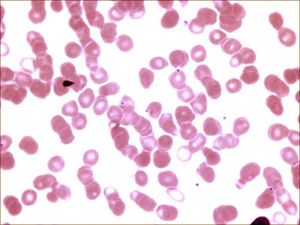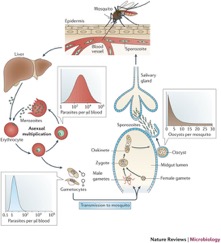Plasmodium falciparum: New Developments: Difference between revisions
No edit summary |
No edit summary |
||
| Line 38: | Line 38: | ||
==Background== | ==Background== | ||
<i>Plasmodium falciparum</i> is a protozoan of the eukaryotic domain. It is widely known in today's world as one of the most common malarial parasites. This particular species causes malignant malaria, which leads to the most complications and mortality rates of all malaria-causing agents. It is estimated that between 300 million and 500 million people are afflicted with malaria annually (WHO). The majority of these incidences of malaria occur in sub-Saharan Africa and affect children under 5. According to the CDC, there are 156 species of <i>Plasmodium</i>, four of which are considered parasitic to humans. These include <i>P. falciparum, P. vivax, P. ovale and P. malaria</i>. Plasmodium falciparum has the highest rate of malarial infection among the four species <ref>[https://www.cdc.gov/dpdx/malaria/]</ref>. We know for a fact that <i>P. falciparum</i> is a malarial parasite that targets humans. What is relatively unknown, however, is the exact mechanism by which the protozoa are able to enter the cell and cause disease. | <i>Plasmodium falciparum</i> is a protozoan of the eukaryotic domain. It is widely known in today's world as one of the most common malarial parasites. This particular species causes malignant malaria, which leads to the most complications and mortality rates of all malaria-causing agents. It is estimated that between 300 million and 500 million people are afflicted with malaria annually (WHO). The majority of these incidences of malaria occur in sub-Saharan Africa and affect children under 5. According to the CDC, there are 156 species of <i>Plasmodium</i>, four of which are considered parasitic to humans. These include <i>P. falciparum, P. vivax, P. ovale and P. malaria</i>. <i>Plasmodium falciparum</i> has the highest rate of malarial infection among the four species <ref>[https://www.cdc.gov/dpdx/malaria/]</ref>. We know for a fact that <i>P. falciparum</i> is a malarial parasite that targets humans. What is relatively unknown, however, is the exact mechanism by which the protozoa are able to enter the cell and cause disease. | ||
<br> | <br> | ||
<br> | <br> | ||
Revision as of 14:44, 28 April 2017
Section
By Charley Myers
Introduction
Plasmodium falciparum is a protozoan of the eukaryotic domain. It is most widely known in today's world as one of the most common malarial parasites. This particular species causes malignant malaria, which leads to the most complications and mortality rates of any other malaria-causing agent. [1]
At right is a sample image insertion. It works for any image uploaded anywhere to MicrobeWiki.
The insertion code consists of:
Double brackets: [[
Filename: PHIL_1181_lores.jpg
Thumbnail status: |thumb|
Pixel size: |300px|
Placement on page: |right|
Legend/credit: Electron micrograph of the Ebola Zaire virus. This was the first photo ever taken of the virus, on 10/13/1976. By Dr. F.A. Murphy, now at U.C. Davis, then at the CDC.
Closed double brackets: ]]
Other examples:
Bold
Italic
Subscript: H2O
Superscript: Fe3+
Introduce the topic of your paper. What is your research question? What experiments have addressed your question? Applications for medicine and/or environment?
Sample citations: [2]
[3]
A citation code consists of a hyperlinked reference within "ref" begin and end codes.
Background
Plasmodium falciparum is a protozoan of the eukaryotic domain. It is widely known in today's world as one of the most common malarial parasites. This particular species causes malignant malaria, which leads to the most complications and mortality rates of all malaria-causing agents. It is estimated that between 300 million and 500 million people are afflicted with malaria annually (WHO). The majority of these incidences of malaria occur in sub-Saharan Africa and affect children under 5. According to the CDC, there are 156 species of Plasmodium, four of which are considered parasitic to humans. These include P. falciparum, P. vivax, P. ovale and P. malaria. Plasmodium falciparum has the highest rate of malarial infection among the four species [4]. We know for a fact that P. falciparum is a malarial parasite that targets humans. What is relatively unknown, however, is the exact mechanism by which the protozoa are able to enter the cell and cause disease.
==
Include some current research, with at least one figure showing data.
Section 3
Include some current research, with at least one figure showing data.
Section 4
Conclusion
References
Authored for BIOL 238 Microbiology, taught by Joan Slonczewski, 2017, Kenyon College.






